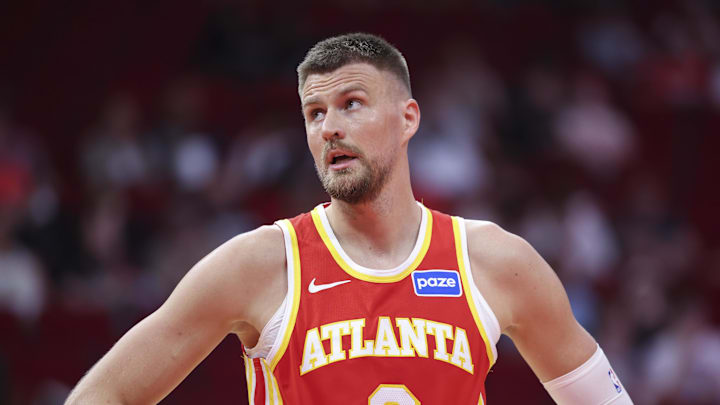As teams gameplan for the new-look Atlanta Hawks roster, Kristaps Porzingis’s shooting presents a problem few teams are equipped to handle. His unique combination of size and three-level scoring demands opponents’ full attention, which often leaves the opposing center defending on the perimeter.
Most teams feature relatively slow-footed big men whose defensive impact is minimized when guarding a spot-up threat like Porzingis. The Houston Rockets, led by a center rotation of Alperen Sengun and Steven Adams, are no exception.
In Atlanta’s preseason opener, the Rockets gave the team its first headache of the season by starting the game with Sengun matched up on Dyson Daniels, allowing Jabari Smith Jr. to guard Porzingis. Smith Jr. has the same wingspan and height as Sengun, allowing him to contest Porzingis’s jumpshots as capably as their center could. Sengun then sagged far off Daniels to maintain his interior presence.
While this strategy was employed for just a matter of minutes, teams with centers slightly more mobile than Sengun could negate Porzingis’s floor-spacing ability by defending Daniels with their center more often.
There are a few obvious counters to this. Daniels said in a presser following the game that they plan to push the ball in transition to expose his matchup’s speed disadvantage. While this will prove to be fruitful, not all possessions can be fast breaks. In the halfcourt, Daniels could expose the mismatch by acting as the screener for Trae Young. Alternatively, Porzingis can exploit his presumably weaker defender by working in the high post, one of his favorite spots on the floor.
The Hawks must prove that teams cannot employ this strategy
Atlanta has the talent, energy, and youth to be a terrifying transition threat. Daniels has a natural advantage in the fast break with his defensive presence, and his athleticism enables him to run the floor with the best of them. However, Daniels’ transition presence does not necessarily prevent teams from matching their center onto him; it merely limits how frequently they can. The Hawks will have to supplement their high-tempo offense with a halfcourt counter.
Quin Snyder tends to prefer a spread pick and roll scheme, and with 48 minutes of stretch five play between Porzingis and Onyeka Okongwu, he can be more creative while staying within his wheelhouse. If a player like Smith Jr. defends Porzingis, his value as a screener is diminished. Instead, Daniels would have the team’s weakest perimeter defender.
A Daniels-Young pick and roll could be lethal against this defensive alignment. Daniels is a strong finisher at the rim and could become one of Young’s favorite lob partners. The short roll, however, is where he would shine the brightest. A capable passer with a high basketball IQ, Daniels could weaponize his own slashing prowess to collapse the defense and create easy scoring opportunities with a pass to the open man.
Of course, Porzingis could also punish this alignment himself. With his high center of gravity, Porzingis has infamously struggled to move smaller defenders in the post. Against smaller defenders, however, Porzingis can simply rise and shoot over them. This area is where Porzingis thrives, finishing last season as one of the elite post up threats in the league.
Between the combination of Daniels and Porzingis’s unique offensive game, Atlanta has a variety of options to exploit teams employing this strategy. Snyder has likely addressed this defensive alignment in training camp to prepare the team for it. Whether the Hawks will be able to execute in these situations is a different question, however. When Houston faces Atlanta tomorrow, expect a thoughtful counter to this strategy from Atlanta’s offense.
